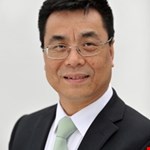The UK is a world leader of lightweight vehicle technologies led by JLR with its aluminium intensive vehicle structures and now its automotive industry is highly productive compared to the leading vehicle producing countries. This has meant that companies like Magna have been encouraged to invest in the UK automotive industry rather than in Germany and to establish strong links with JLR as the OEM of choice for further utilisation of aluminium body castings. In 2013 only 35% of parts for vehicles were sourced in the UK compared to a comparable figure of 60% for Germany.
Since 2013 based on the lead from the Automotive Council supported by the UK government more than £3 billion of this supply has been restored in the UK and employment in this sector has doubled. Vehicle production in the UK peaked in 1972 and is approaching record levels again with 1.6 million vehicles produced in 2015 and by 2020 it is expected that production will exceed 2 million vehicles. It has been estimated that the value of global automotive R&D that is based in the UK is in excess of £2.3 billion. There is still a huge potential for further UK based casting supply in the UK and this has been estimated to be worth more than £1.5 billion annually and a significant portion of this will be the supply of aluminium castings for lightweight vehicle structures.
Recently it has become apparent that there is a large and growing divergence between the measured CO2 emissions and what actually happens when cars are driven on the road. This means that the vehicle OEMs are much further away from delivering CO2 reduction from vehicles than has been widely promulgated and that the legislated requirements for 2020 and beyond will be much more difficult to achieve if realistic testing becomes the way of measuring actual CO2 vehicle emissions. The present NEDC (New European Drive Cycle) test method will be replaced by the more realistic WLTP (Worldwide harmonized Light vehicles Test Procedure) in 2017 although the CO2 targets will be softened to allow manufacturers time to cope with the more demanding actual emission based requirements. This will make life very challenging for all OEMs unless they make their emission reduction technologies much more effective.
Multiple emission reduction technologies have been identified but far and away the most important effective and relevant reduction technology is vehicle lightweighting. This CO2 reduction technology will get the largest boost from the new situation as most of the simple lower cost alternative technology options have already been exploited. Aluminium automotive sheet technology for body-in-white is well established, particularly within JLR, and more manufacturers will need to switch to aluminium intensive bodies rather than hang-on parts to respond to their now urgent and increased need for weight reduction. However thin walled casting remain as a particular challenge due mainly to the limitation in the present high pressure diecasting technology. The key figure is that a 40% reduction in minimum wall thickness of a structural casting would result in a 20% weight reduction.
The overall challenge of balancing these market requirements has created an opportunity for the UK to support the increasing global demand for structural aluminium body castings for low carbon vehicles whilst further growing high value automotive R&D in the UK supply base. An initial assessment has identified an economic growth opportunity for UK business of approximately £2 billion per year by producing a new generation of high value aluminium thin wall diecastings with optimised heat treatment for applications in automotive structures and then cross-sector into both aerospace and defence applications.
Meet the Principal Investigator(s) for the project

Professor Zhongyun Fan - Fan is a professor of metallurgy, the founder and Director of BCAST at Brunel University London. He is the principal investigator/director of the EPSRC funded LiME Research Hub, a national centre of excellence in liquid metal engineering. He is also the principal investigator for the UKRI Interdisciplinary Circular Economy Centre for Circular Metals.
He has published over 400 scientific papers with an H-Index of 59 and a total citation of 14071 (Google Scholar). He has led a wide range of research projects as principal investigator with grants totalling over £70M.
He has been chairman of 4 major international conferences and members international scientific committee of 6 international conferences. He was the co-chairmen of the Casting and Solidification Society (IOM3, 2012-2018), is a Board Member of the Light Metals Division (IOM3), a Fellow of the Institute of IOM3 and the Institute of Cast Metal Engineers (ICME). He was the recipient of the Elegant Work Prize (1995), the Cook/Ablett Award (2003) and Dowding Medal and Prize (2012) of the Institute of Materials, Minerals and Mining (IOM3).
He obtained his first degree in Metallurgy from University of Science and Technology Beijing and his PhD in Materials Science and Engineering from University of Surrey. He started his academic career in 1997 at Brunel University, and prior to this he was a research fellow at University of Oxford and University of Surrey.
Partnering with confidence
Organisations interested in our research can partner with us with confidence backed by an external and independent benchmark: The Knowledge Exchange Framework. Read more.
Project last modified 21/11/2023